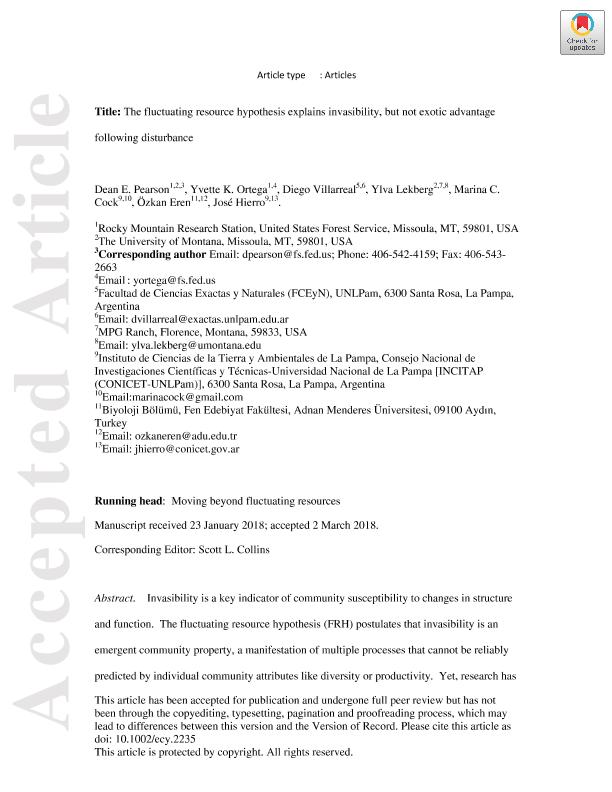Mostrar el registro sencillo del ítem
dc.contributor.author
Pearson, Dean

dc.contributor.author
Ortega, Yvette K.
dc.contributor.author
Villarreal, Diego

dc.contributor.author
Lekberg, Ylva
dc.contributor.author
Cock, Marina Cecilia

dc.contributor.author
Eren, Ozkan

dc.contributor.author
Hierro, Jose Luis

dc.date.available
2020-02-11T20:19:51Z
dc.date.issued
2018-06
dc.identifier.citation
Pearson, Dean; Ortega, Yvette K.; Villarreal, Diego; Lekberg, Ylva; Cock, Marina Cecilia; et al.; The fluctuating resource hypothesis explains invasibility, but not exotic advantage following disturbance; Ecological Society of America; Ecology; 99; 6; 6-2018; 1296-1305
dc.identifier.issn
0012-9658
dc.identifier.uri
http://hdl.handle.net/11336/97218
dc.description.abstract
Invasibility is a key indicator of community susceptibility to changes in structure and function. The fluctuating resource hypothesis (FRH) postulates that invasibility is an emergent community property, a manifestation of multiple processes that cannot be reliably predicted by individual community attributes like diversity or productivity. Yet, research has emphasized the role of these individual attributes, with the expectation that diversity should deter invasibility and productivity enhance it. In an effort to explore how these and other factors may influence invasibility, we evaluated the relationship between invasibility and species richness, productivity, resource availability, and resilience in experiments crossing disturbance with exotic seed addition in 1-m2 plots replicated over large expanses of grasslands in Montana, USA and La Pampa, Argentina. Disturbance increased invasibility as predicted by FRH, but grasslands were more invasible in Montana than La Pampa whether disturbed or not, despite Montana´s higher species richness and lower productivity. Moreover, invasibility correlated positively with nitrogen availability and negatively with native plant cover. These patterns suggested that resource availability and the ability of the community to recover from disturbance (resilience) better predicted invasibility than either species richness or productivity, consistent with predictions from FRH. However, in ambient, unseeded plots in Montana, disturbance reduced native cover by >50% while increasing exotic cover >200%. This provenance bias could not be explained by FRH, which predicts that colonization processes act on species? traits independent of origins. The high invasibility of Montana grasslands following disturbance was associated with a strong shift from perennial to annual species, as predicted by succession theory. However, this shift was driven primarily by exotic annuals, which were more strongly represented than perennials in local exotic vs. native species pools. We attribute this provenance bias to extrinsic biogeographic factors such as disparate evolutionary histories and/or introduction filters selecting for traits that favor exotics following disturbance. Our results suggest that (1) invasibility is an emergent property best explained by a community´s efficiency in utilizing resources, as predicted by FRH but (2) understanding provenance biases in biological invasions requires moving beyond FRH to incorporate extrinsic biogeographic factors that may favor exotics in community assembly.
dc.format
application/pdf
dc.language.iso
eng
dc.publisher
Ecological Society of America

dc.rights
info:eu-repo/semantics/openAccess
dc.rights.uri
https://creativecommons.org/licenses/by-nc-sa/2.5/ar/
dc.subject
COMMUNITY ASSEMBLY
dc.subject
DIVERSITY
dc.subject
FLUCTUATING RESOURCE HYPOTHESIS
dc.subject
INVASIBILITY
dc.subject
INVASION
dc.subject
PRODUCTIVITY
dc.subject
RESILIENCE
dc.subject
RESOURCE AVAILABILITY
dc.subject.classification
Ecología

dc.subject.classification
Ciencias Biológicas

dc.subject.classification
CIENCIAS NATURALES Y EXACTAS

dc.title
The fluctuating resource hypothesis explains invasibility, but not exotic advantage following disturbance
dc.type
info:eu-repo/semantics/article
dc.type
info:ar-repo/semantics/artículo
dc.type
info:eu-repo/semantics/publishedVersion
dc.date.updated
2019-10-22T17:27:18Z
dc.journal.volume
99
dc.journal.number
6
dc.journal.pagination
1296-1305
dc.journal.pais
Estados Unidos

dc.journal.ciudad
Washington DC
dc.description.fil
Fil: Pearson, Dean. United State Forest Service; Estados Unidos. University of Montana; Estados Unidos
dc.description.fil
Fil: Ortega, Yvette K.. United State Forest Service; Estados Unidos
dc.description.fil
Fil: Villarreal, Diego. Universidad Nacional de La Pampa. Facultad de Ciencias Exactas y Naturales; Argentina
dc.description.fil
Fil: Lekberg, Ylva. University of Montana; Estados Unidos
dc.description.fil
Fil: Cock, Marina Cecilia. Consejo Nacional de Investigaciones Científicas y Técnicas. Instituto de Ciencias de la Tierra y Ambientales de La Pampa. Universidad Nacional de La Pampa. Facultad de Ciencias Exactas y Naturales. Instituto de Ciencias de la Tierra y Ambientales de La Pampa; Argentina
dc.description.fil
Fil: Eren, Ozkan. Adnan Menderes Universitesi; Turquía
dc.description.fil
Fil: Hierro, Jose Luis. Consejo Nacional de Investigaciones Científicas y Técnicas. Instituto de Ciencias de la Tierra y Ambientales de La Pampa. Universidad Nacional de La Pampa. Facultad de Ciencias Exactas y Naturales. Instituto de Ciencias de la Tierra y Ambientales de La Pampa; Argentina
dc.journal.title
Ecology

dc.relation.alternativeid
info:eu-repo/semantics/altIdentifier/url/http://doi.wiley.com/10.1002/ecy.2235
dc.relation.alternativeid
info:eu-repo/semantics/altIdentifier/doi/https://doi.org/10.1002/ecy.2235
Archivos asociados
